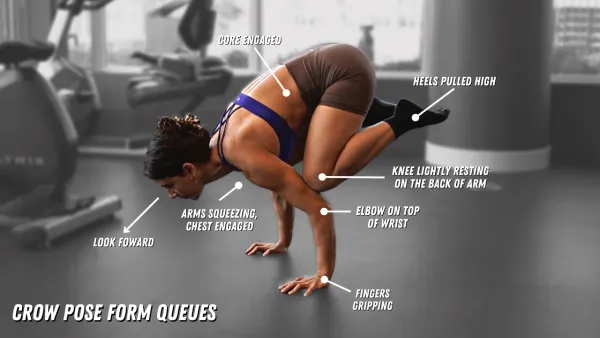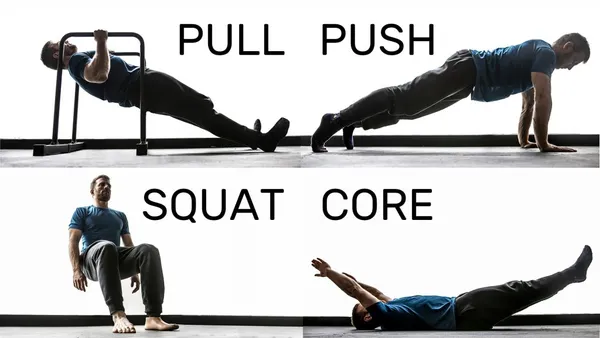Table of Contents
Welcome to Kizworld's comprehensive guide on How to get started with calisthenics as a beginner. Calisthenics, a bodyweight training method, offers a convenient and effective way to improve your fitness. Embark on this journey to discover the fundamentals, essential exercises, and tips that will help you achieve your fitness goals. Get ready to transform your body and elevate your strength with calisthenics.
How to Get Started with Calisthenics as a Beginner: A Comprehensive Guide
I. Calisthenics Exercises for Beginners
Calisthenics Exercises for Beginners
Bodyweight Squats
Squats are a fundamental exercise that targets the lower body, particularly the quadriceps, hamstrings, and glutes. To perform a bodyweight squat, stand with your feet shoulder-width apart, toes slightly turned out. Bend your knees and hips, lowering your body as if sitting back into a chair. Keep your chest up and your back straight. Return to the starting position by extending your knees and hips. Aim for 10-12 repetitions.
- Benefits: Builds lower body strength, improves balance and coordination, and promotes functional movement.
- Progression: Gradually increase the depth of your squats and the number of repetitions as you gain strength.
Push-Ups
Push-ups are a classic exercise that works the chest, triceps, and shoulders. To perform a push-up, start in a plank position with your hands shoulder-width apart and your feet together. Bend your elbows and lower your body until your chest is almost touching the ground. Press back up to the starting position. Aim for 8-10 repetitions.
- Benefits: Builds upper body strength, improves posture, and strengthens the core.
- Progression: Start with knee push-ups if you find regular push-ups too challenging. Gradually increase the number of repetitions and transition to full push-ups as you get stronger.
Lunges
Lunges are a great exercise for targeting the quads, hamstrings, and glutes. To perform a lunge, step forward with one leg and bend your knee, lowering your body until your front thigh is parallel to the ground. Keep your back straight and your front knee aligned with your ankle. Push back up to the starting position and repeat with the other leg. Aim for 10-12 repetitions on each leg.
- Benefits: Improves lower body strength, balance, and coordination.
- Progression: Start with bodyweight lunges and gradually add weight as you get stronger.
Plank
The plank is an isometric exercise that engages the entire body, particularly the core, shoulders, and back. To perform a plank, start in a push-up position with your forearms on the ground and your body in a straight line from head to heels. Hold this position for as long as you can, maintaining proper form. Aim for 30-60 seconds.
- Benefits: Strengthens the core, improves posture, and enhances overall stability.
- Progression: Gradually increase the duration of your plank hold as you get stronger.
Tricep Dips
Tricep dips are an effective exercise for targeting the triceps. To perform a tricep dip, find a sturdy bench or chair and place your hands on the edge, shoulder-width apart. Extend your legs and lower your body by bending your elbows, keeping your chest up and your back straight. Press back up to the starting position. Aim for 8-10 repetitions.
- Benefits: Builds tricep strength, improves upper body definition, and enhances functional movement.
- Progression: Start with assisted dips using a resistance band or have a partner support your legs. Gradually reduce the assistance as you get stronger.
Incline Rows
Incline rows are a great exercise for working the back muscles, particularly the lats and biceps. To perform an incline row, find an inclined bench or sturdy surface. Place your feet on the ground and grab the handles of a dumbbell or resistance band with an overhand grip. Pull the weight towards your chest, keeping your elbows close to your body. Lower the weight back to the starting position. Aim for 8-10 repetitions.
- Benefits: Strengthens the back muscles, improves posture, and enhances upper body definition.
- Progression: Start with a light weight or resistance band and gradually increase the resistance as you get stronger.
Calf Raises
Calf raises are an isolation exercise that targets the calf muscles. To perform a calf raise, stand with your feet shoulder-width apart and your toes slightly turned out. Slowly raise your heels up until you feel a stretch in your calves. Hold the position for a few seconds and then lower your heels back down. Aim for 15-20 repetitions.
- Benefits: Strengthens the calf muscles, improves balance, and enhances athletic performance.
- Progression: Start with bodyweight calf raises and gradually add weight as you get stronger.
Wall Sit
The wall sit is a simple yet effective exercise that targets the quadriceps, hamstrings, and glutes. To perform a wall sit, stand with your back against a wall and your feet shoulder-width apart. Slowly slide down the wall until your thighs are parallel to the ground. Hold this position for as long as you can, maintaining proper form. Aim for 30-60 seconds.
- Benefits: Builds lower body strength, improves endurance, and enhances functional movement.
- Progression: Gradually increase the duration of your wall sit hold as you get stronger.
Conclusion
These exercises provide a solid foundation for beginners to start their calisthenics journey. Remember to focus on proper form, progress gradually, and listen to your body. With dedication and consistency, you can achieve your fitness goals and unlock the full potential of calisthenics.
II. Calisthenics Diet and Nutrition
Calisthenics Diet and Nutrition
Fueling Your Body for Success
A balanced diet is essential for optimal performance in any physical activity, and calisthenics is no exception. Eating a variety of nutrient-rich foods will provide your body with the energy and building blocks it needs to build muscle, recover from workouts, and perform at your best. Here are some key dietary considerations for calisthenics athletes:
- Protein: Protein is essential for building and repairing muscle tissue. Aim for 1.2-2.0 grams of protein per kilogram of body weight per day.
- Carbohydrates: Carbohydrates provide energy for your workouts. Choose whole grains, fruits, and vegetables over processed foods and sugary drinks.
- Fats: Healthy fats are important for hormone production and overall health. Include sources of healthy fats such as nuts, seeds, and avocados in your diet.
- Vitamins and Minerals: Vitamins and minerals are essential for overall health and well-being. Eat a variety of fruits, vegetables, and whole grains to ensure you're getting the vitamins and minerals you need.
- Water: Staying hydrated is crucial for overall health and performance. Drink plenty of water throughout the day, especially before, during, and after workouts.
Supplements
While a balanced diet is the foundation of a healthy lifestyle, some supplements can be beneficial for calisthenics athletes. These supplements can help improve performance, recovery, and overall health. Some popular supplements for calisthenics athletes include:
- Creatine: Creatine is a natural substance that helps muscles produce energy. It can improve strength and power output, especially during short, high-intensity workouts.
- BCAAs: BCAAs (branched-chain amino acids) are essential amino acids that are important for muscle growth and repair. They can help reduce muscle soreness and improve recovery.
- Glutamine: Glutamine is an amino acid that is important for muscle recovery and immune function. It can help reduce muscle soreness and improve recovery from intense workouts.
- Fish Oil: Fish oil is a source of omega-3 fatty acids, which are important for heart health and overall well-being. They can also help reduce inflammation and improve recovery.
- Multivitamin: A multivitamin can help ensure that you're getting all the vitamins and minerals you need, especially if you have a restrictive diet or are not eating a variety of foods.
Timing Your Meals
The timing of your meals can also impact your performance and recovery. Here are some general guidelines for timing your meals:
- Pre-workout: Eat a meal or snack that is high in carbohydrates and moderate in protein about 1-2 hours before your workout. This will provide you with energy and help you perform at your best.
- Post-workout: Within 30 minutes of finishing your workout, consume a meal or snack that is high in protein and carbohydrates. This will help your muscles recover and rebuild.
- Throughout the day: Eat regular meals and snacks throughout the day to ensure that you're getting the nutrients you need to support your training and recovery.
Conclusion
By following these dietary guidelines, you can fuel your body for success in calisthenics. Remember, a balanced diet is the foundation of a healthy lifestyle, and supplements should only be used to complement a healthy diet and training program.
For more information on calisthenics nutrition, check out our article on The Best Calisthenics Supplements and Nutrition.
III. Calisthenics Training Schedule
Calisthenics Training Schedule
As a beginner starting calisthenics, a well-structured training schedule can optimize your progress and minimize the risk of injuries. Here's an effective 3-day split routine to follow:
- Day 1: Upper Body Push
- Day 2: Rest
- Day 3: Lower Body and Core
- Day 4: Rest
- Day 5: Upper Body Pull
- Day 6: Rest
- Day 7: Active Recovery (Optional)
Customize the workout frequency and intensity based on your fitness level and goals. Remember to warm up before each workout and cool down afterward. Find more calisthenics exercises here.
Day 1: Upper Body Push
Exercise | Sets | Repetitions |
|---|---|---|
Push-Ups | 3 | 8-12 |
Incline Push-Ups | 3 | 8-12 |
Pike Push-Ups | 3 | 6-8 |
Triceps Dips | 3 | 8-12 |
Overhead Press | 3 | 6-8 |
Shoulder Press | 3 | 8-12 |
Remember to focus on maintaining proper form throughout the exercises. Modify the exercises or reduce the repetitions if needed.
Day 3: Lower Body and Core
Exercise | Sets | Repetitions |
|---|---|---|
Squats | 3 | 8-12 |
Lunges | 3 | 8-12 (each leg) |
Calf Raises | 3 | 15-20 |
Plank | 3 | Hold for 30-60 seconds |
Side Plank | 3 | Hold for 30-60 seconds (each side) |
Bicycle Crunches | 3 | 15-20 |
Leg Raises | 3 | 15-20 |
Don't forget to incorporate dynamic stretches before your workouts and static stretches afterward for improved flexibility and reduced muscle soreness. Find more tips on improving flexibility with calisthenics here.
Day 5: Upper Body Pull
Exercise | Sets | Repetitions |
|---|---|---|
Pull-Ups/Chin-Ups | 3 | As many as possible |
Inverted Rows | 3 | 8-12 |
Bicep Curls | 3 | 8-12 |
Hammer Curls | 3 | 8-12 |
Lat Pull-Downs | 3 | 8-12 |
Rear Delt Flyes | 3 | 8-12 |
Start with the basics and gradually progress to more advanced exercises as you gain strength and confidence. Read more about basic calisthenics skills to enhance your training.
IV. Calisthenics Safety and Injury Prevention
Calisthenics Safety and Injury Prevention
Calisthenics, like any physical activity, carries a risk of injury. However, by following proper safety guidelines and techniques, you can minimize these risks and enjoy a safe and rewarding calisthenics journey. Here are some essential safety tips to keep in mind:
- Warm up properly: Always start your workout with a dynamic warm-up to prepare your muscles and joints for the exercises ahead. This can include light cardio, stretching, and activation exercises.
- Use proper form: Maintaining proper form during exercises is crucial to prevent injuries. Focus on engaging the correct muscles, keeping your body aligned, and avoiding excessive strain or momentum.
- Listen to your body: Pay attention to how your body feels during exercises. If you experience pain or discomfort, stop the exercise and assess the situation. Pushing through pain can lead to further injury.
- Progress gradually: Avoid jumping into advanced exercises too quickly. Start with beginner-friendly movements and gradually increase the difficulty as you gain strength and skill.
- Use spotters when necessary: For challenging exercises like muscle-ups or handstands, consider having a spotter to assist you and ensure your safety.
In addition to these general safety tips, there are specific precautions you can take to prevent common calisthenics injuries:
- Wrist pain: To avoid wrist pain, focus on maintaining a neutral wrist position during exercises. Avoid excessive bending or flexing of the wrists.
- Shoulder pain: To prevent shoulder pain, warm up your shoulders properly and avoid exercises that cause discomfort. Use proper form and avoid excessive overhead movements.
- Lower back pain: To protect your lower back, engage your core muscles during exercises and avoid excessive arching or rounding of the back.
- Knee pain: To prevent knee pain, focus on maintaining proper alignment and avoid exercises that put excessive stress on the knees.
By following these safety guidelines and listening to your body, you can minimize the risk of injuries and enjoy the benefits of calisthenics safely and effectively. Remember, safety should always be your top priority during any workout.
Injury | Prevention |
Wrist pain | Maintain neutral wrist position, avoid excessive bending or flexing |
Shoulder pain | Warm up properly, avoid exercises causing discomfort, use proper form |
Lower back pain | Engage core muscles, avoid excessive arching or rounding of the back |
Knee pain | Maintain proper alignment, avoid exercises stressing the knees |
If you experience persistent pain or discomfort during calisthenics exercises, it's essential to consult a qualified healthcare professional for proper assessment and guidance.
Remember, calisthenics is a challenging but rewarding form of exercise. By prioritizing safety and following proper techniques, you can unlock your full potential and achieve your fitness goals without compromising your well-being.
To learn more about calisthenics safety and injury prevention, check out our comprehensive guide on Common Calisthenics Injuries and How to Prevent Them.
V. Conclusion
Calisthenics is a journey of personal growth, physical achievement, and self-discovery. As you progress in your calisthenics practice, remember to stay patient, consistent, and focused on your goals. Embrace the challenges, celebrate your successes, and continuously strive for improvement. With dedication and perseverance, you'll unlock your full potential and achieve a healthier, fitter, and more confident version of yourself. Calisthenics is not just an exercise routine; it's a lifestyle that empowers you to take control of your physical well-being and cultivate a strong, capable body. Begin your calisthenics journey today and experience the transformative power of bodyweight training.